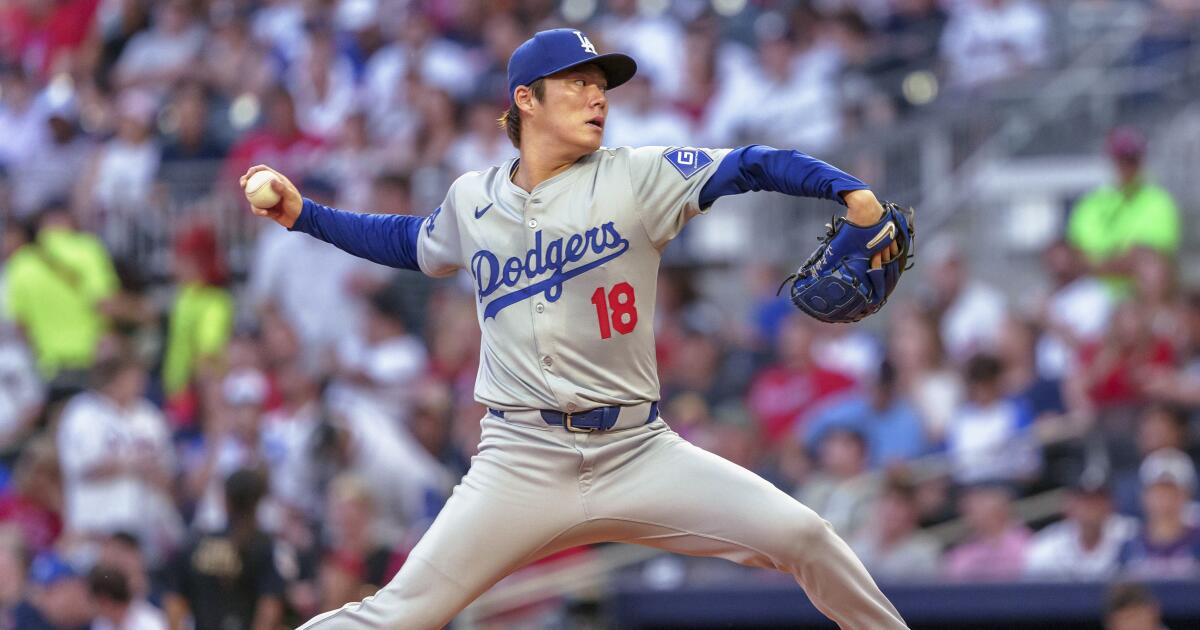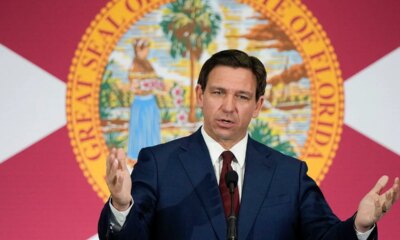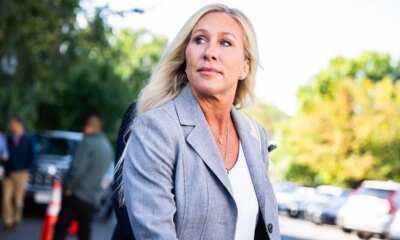Sports
Yoshinobu Yamamoto bends but doesn't break as Dodgers split series versus Braves

Last week, Yoshinobu Yamamoto looked almost unhittable in his long-awaited return from the injured list.
In Monday night’s encore at Truist Park, the rookie Japanese right-hander had to be unbreakable instead.
In all four of Yamamoto’s innings against the Atlanta Braves, the leadoff man reached base. All four times, they eventually made it to third.
But, in a 9-0 Dodgers’ win that secured a four-game series split, Yamamoto managed to escape each jam, pitching four scoreless innings in another encouraging sign for his October prospects.
“It wasn’t as sharp command-wise as his first one back, but he made pitches when he needed to,” manager Dave Roberts said. “I just love the way he navigated.”
Yamamoto was not as crisp Monday as he was in his return from the injured list last week against the Chicago Cubs, when he struck out eight batters and gave up just a lone unearned run in his first start in three months after battling a strained rotator cuff.
Against the Braves, Yamamoto didn’t replicate his nearly perfect fastball command, contributing to a couple of first-inning walks. He sprayed more off-speed pitches, leaving him routinely behind the count. He also only averaged around 95-96 mph with his heater, a tick down from his adrenaline-fueled return six days previous, while giving up four hits (three of them for extra bases).
Yet, every time his back was against the wall, Yamamoto found a way to respond.
“I focused on one hitter at a time,” Yamamoto said through an interpreter. “And stayed calm.”
With runners on the corners in the first, he induced a weak ground ball to end the inning. After both a leadoff double from Sean Murphy in the second inning and a leadoff triple from Ramon Laureano in the fourth, Yamamoto retired the next three batters in a row.
The only time the $325-million offseason signing needed some help was in the third. Following a leadoff single from Michael Harris II, Jorge Soler hit a double to deep center that had Harris trying to score from first. From second base, however, Kiké Hernández made a perfect tumbling relay throw to the plate, completing half a front flip to gun down Harris in a momentum-shifting sequence.
“The throw was unbelievable,” Roberts said. “That’s a hard throw. That’s a hard play.”
At the plate, the Dodgers were in full factory mode, manufacturing nine runs on just four hits while walking seven times and going three for seven with runners in scoring position.
Miguel Rojas scored off a leadoff walk in the third, after avoiding a double-play at second base, stealing third and then getting a good jump on a wild pitch from Braves starter Max Fried to race home.
Tommy Edman and Rojas both scored in the fifth inning after hitting a double and single, respectively, to lead off the frame.
Then, the Dodgers hung a six-spot against Atlanta’s bullpen in the seventh, playing more small ball until Freddie Freeman broke things open with a three-run homer over the short wall down the left field line.
The win moved the Dodgers (89-61) four games clear of the second-place San Diego Padres (who had yet to finish their game Monday night) in the National League West, lowering their magic number to clinch the division crown to nine.
But more important, it offered another blueprint of how they could potentially win games in October, with a Yamamoto-led template almost certain to be required for the team to make a serious World Series run.
The Dodgers have many injuries to their pitching staff. Will this lead to Shohei Ohtani becoming a pitching hero in the playoffs?
“It’s a shot in the arm,” Roberts said of Yamamoto’s return to the club. “He knows how valuable [he is] and what he means to our ballclub. And he’s delivered. So now these last two starts [he will make in the regular season], I feel good that we’ve got a good foundation. We’re almost there to the point where we can just let him go.”
Yamamoto is not without limitations.
He is still in build-up mode, limited to only 72 pitches Monday as he continues to regain stamina after his time on the IL.
He has also been extremely selective with his use of the slider — a pitch known to give him arm troubles during his time in Japan’s Nippon Professional Baseball league — throwing it only three times Monday while mixing in more cutters instead (though he said Monday that he wasn’t intentionally shying away from it).
Before the game, Roberts also confirmed that Yamamoto will not pitch on regular four days’ rest in any of his remaining regular season starts; continuing the trend of five days off or more between starts that he was accustomed to in Japan. It is unlikely that Yamamoto, who has not pitched on four days’ rest all season, would do so in the playoffs, either.
“It’s kind of where we’re at,” Roberts said. “We’ve got to figure out how best to keep him fresh, sharp, prepared, number one. Then number two, fill in the pieces. Shoot, I’d love to have four guys that can go on short rest or regular rest. But it’s just not feasible.”
Indeed, the Dodgers’ pitching staff is not in the place they hoped it would be at this point of the year.
Tyler Glasnow’s season is over because of a sprained elbow. Gavin Stone is almost certain to remain sidelined himself because of shoulder inflammation, though he still plans to try and start catch play again this week. Clayton Kershaw’s status is also unclear as he continues to battle his toe injury.
But the Dodgers still have Jack Flaherty, their top trade deadline acquisition. They’re optimistic about Walker Buehler, a tested postseason pitcher who has looked better in recent weeks. And most of all, they have Yamamoto, who backed up his big return from injury with an equally auspicious, if not equally dominant, second act.
“To muscle through four innings and get out of massive jams probably boosted his confidence, and ours,” Freeman said. “It’s a good end to the series and a big confidence boost for everyone in here.”
Austin Barnes on injured list
As expected, backup catcher Austin Barnes was placed on the injured list Monday after suffering a broken left big toe the previous night. It’s the second time in the last two months that Barnes has suffered a fracture to the toe, but the Dodgers are hopeful he will be able to return before the end of the regular season.
Triple-A catcher Hunter Feduccia was called up in Barnes’ place Monday.
“I hope it’s one of those things, given his role, that if we can calm it down, keep it at bay we can get him back in 16 days,” Roberts said. “Hopefully it’s not the end of the season for him.”

Sports
Jerry Jones opens up on Cowboys’ shortcomings during 2025 season

NEWYou can now listen to Fox News articles!
The Dallas Cowboys’ Super Bowl drought increased to 30 years as the team was eliminated from playoff contention on Saturday and then lost to the Los Angeles Chargers on Sunday.
The Cowboys showed tremendous heart during the season after the defense was gutted when star pass rusher Micah Parsons was traded to the Green Bay Packers. Dallas picked up big wins over the Kansas City Chiefs, Philadelphia Eagles and New York Giants, as well as a tie with the Packers.
Dallas Cowboys owner Jerry Jones before a game against the Minnesota Vikings at AT&T Stadium on Dec. 14, 2025. (Kevin Jairaj/Imagn Images)
Ultimately, the Cowboys lost their last three games and found themselves on the outside looking in on the playoffs once more. Dallas dropped to 6-8-1 after the loss to Los Angeles, and team owner Jerry Jones opened up about some of the team’s shortcomings.
“I really am better when I’m getting my a– kicked than I am when I’m having success,” he said, via The Athletic. “I’ve seen some of the decisions I’ve made work.
“We get one team that gets to go to that Super Bowl every year. Two that get to go to those (conference championship) playoff games. I’m looking forward next year to getting back in that championship game and maybe beyond. And then I’ll be right at the top of the list of how long it’s been since you’ve been to one. And that’s how you do it. Right at the top. And this will all go away.”
SHEDEUR SANDERS PUSHES BACK ON QUESTIONS ABOUT COACHING DECISIONS: ‘COME ON, MAN’
Dallas Cowboys quarterback Dak Prescott (4) prepares to pass during the first half of an NFL football game against the Los Angeles Chargers, Sunday, Dec. 21, 2025, in Arlington, Texas. (AP Photo/Julio Cortez)
Jones did take away some positivity from the 2025 season. He acknowledged the team “underachieved” but there were some things that the team could carry forward into 2026.
Particularly, Jones said he was impressed with how Dak Prescott played during the year.
Prescott has 4,175 passing yards and 28 touchdown passes this season. He’s leading the NFL in completions (378) and passing attempts (552). Both George Pickens and CeeDee Lamb eclipsed 1,000 receiving yards for the season.
“I am pleased with what we have in Dak, very pleased going forward,” he said, via the team’s website. “Nothing we’ve done so far this season gives me anything but optimism about going forward at one of the key, if not the key position.”
Bundle FOX One and FOX Nation to stream the entire FOX Nation library, plus live FOX News, Sports, and Entertainment at our lowest price of the year. The offer ends on Jan. 4, 2026. (Fox One; Fox Nation)
CLICK HERE TO DOWNLOAD THE FOX NEWS APP
Dallas has the Washington Commanders and the New York Giants left on its schedule.
Follow Fox News Digital’s sports coverage on X and subscribe to the Fox News Sports Huddle newsletter.
Sports
Palisades starts out as City Section basketball favorite in top 10 rankings

It’s time to take a look at the City Section’s top boys’ basketball teams a little more than a month into the season:
1. PALISADES (2-4): The Popoola twins, EJ and OJ, combined with freshman Phillip Reed, make the Dolphins the City Section Open Division title favorites.
2. WASHINGTON PREP (6-4): Jayshawn Kibble is a candidate for City player of the year.
3. CLEVELAND (5-4): Sophomore guard Charlie Adams becomes eligible Friday.
4. GRANADA HILLS (6-3): Help coming when sit-out transfer period ends Friday.
5. SAN PEDRO (7-3): Lots of varsity experience could result in Marine League title.
6. VENICE (5-8): Win over Fairfax, one-point loss to San Pedro.
7. BIRMINGHAM (4-2): Patriots like being under the radar.
8. TAFT (5-4): Turnaround showing progress ahead of schedule.
9. FAIRFAX (5-2): Young players making progress.
10. EL CAMINO REAL (7-5): One-point loss to Chaminade offers hope.
Sports
Broncos’ Pat Bryant placed on backboard, carted off field after scary hit in loss to Jaguars

NEWYou can now listen to Fox News articles!
Denver Broncos wide receiver Pat Bryant was carted off the field in the loss to the Jacksonville Jaguars after a vicious hit that was scary to look at.
Bryant was attempting to make a catch with just seconds left at Empower Field when Jaguars cornerback Montaric Brown came flying in and crashed into him to break it up.
One could hear how hard Bryant was hit with the broadcast picking up the cracking of helmet and pads as he went to the turf.
Pat Bryant of the Denver Broncos is carted off the field during the fourth quarter against the Jacksonville Jaguars at Empower Field At Mile High on Dec. 21, 2025 in Denver, Colorado. (Justin Edmonds/Getty Images)
Bryant stayed down on the field after the play, and he wasn’t moving much as Broncos trainers came running out to look at him on the turf.
After several minutes of evaluation, Bryant was loaded onto a stretcher and carted off the field. There was obvious concern throughout the stadium for Bryant, and it was later reported that he was taken to the hospital as a precaution.
2025 NFL WEEK 16 BUZZ: PATRICK MAHOMES BEGINS REHAB; ANDY REID NOT RETIRING?
Broncos head coach Sean Payton, speaking after his first loss in 12 games, gave an update on Bryant, saying that he “had movement” in his extremities, and it was “encouraging” to see, per 9News’ Mike Klis.
Of course, any time a player is loaded onto a stretcher, thoughts of the worst immediately enter the mind. Luckily, Bryant’s hospital visit was only to ensure everything was fine.
Pat Bryant of the Denver Broncos is carted off the field during the fourth quarter against the Jacksonville Jaguars at Empower Field At Mile High on Dec. 21, 2025 in Denver, Colorado. (Justin Edmonds/Getty Images)
The Broncos moved to 12-3 after the loss at home, a 34-20 defeat at the hands of a red-hot Jaguars squad who have now won six straight games.
At 11-4, the Jaguars remain one win above the Houston Texans for the AFC South lead, though they are likely headed to the playoffs one way or another.
Meanwhile, the Broncos have already clinched their shot at a Vince Lombardi Trophy, having won 12 games this season for the best record in the AFC to date. Only the New England Patriots could reach 12 wins this week if they defeat the Baltimore Ravens on “Sunday Night Football.”
Bundle FOX One and FOX Nation to stream the entire FOX Nation library, plus live FOX News, Sports, and Entertainment at our lowest price of the year. The offer ends on Jan. 4, 2026. (Fox One; Fox Nation)
Bryant finished the game with five catches for 42 yards. He has totaled 27 catches for 347 yards and a touchdown this season in a loaded Broncos receiving room.
Follow Fox News Digital’s sports coverage on X and subscribe to the Fox News Sports Huddle newsletter.
-

 Iowa1 week ago
Iowa1 week agoAddy Brown motivated to step up in Audi Crooks’ absence vs. UNI
-

 Iowa1 week ago
Iowa1 week agoHow much snow did Iowa get? See Iowa’s latest snowfall totals
-

 Maine6 days ago
Maine6 days agoElementary-aged student killed in school bus crash in southern Maine
-

 Maryland1 week ago
Maryland1 week agoFrigid temperatures to start the week in Maryland
-

 New Mexico6 days ago
New Mexico6 days agoFamily clarifies why they believe missing New Mexico man is dead
-

 South Dakota1 week ago
South Dakota1 week agoNature: Snow in South Dakota
-

 Detroit, MI1 week ago
Detroit, MI1 week ago‘Love being a pedo’: Metro Detroit doctor, attorney, therapist accused in web of child porn chats
-

 Maine6 days ago
Maine6 days agoFamily in Maine host food pantry for deer | Hand Off



















